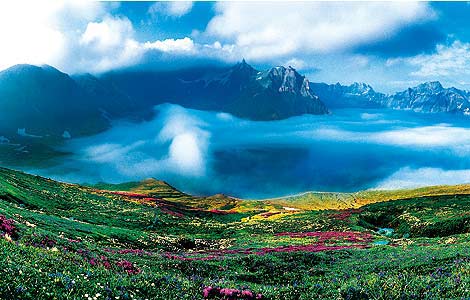
Project guides farmers in reducing pesticides for safer, better fruit
Zou Yongbo used to eat a number of apples every day - maybe not a good sign for someone who is meant to make a living selling them.
"It's hard getting rid of imperfect ones, those that are poorly shaped," said the orchard owner in Yantai, a major fruit growing region in Shandong province. "I usually had to sell them for cheap, throw them out or eat them myself."
Thankfully, he said, the number going to waste has fallen since he signed up for a project run by Bayer CropScience that is trying to reduce pesticide residue on fresh produce.
The company, part of the multinational Bayer Group, began approaching communities in Penglai, a county-level city in Yantai, in 2008. Farmers who signed on receive advice and fertilizers, and have the option of selling directly to a partner of Bayer, Golden Wing Mau, a wholesaler supplying supermarkets worldwide.
The produce is packed in boxes that carry a full breakdown of the cultivation process, listing exactly what types of chemicals were used and how often.
The overuse of pesticides by China's growers has become a major concern in recent years, with various studies showing that many consumers are dubious about the supervision and safety of homegrown produce.
"Informing the public of where the apples are from and how they were cultivated better guarantees their sale," Zou said, adding that the improved quality and reduced sales chain have helped increase his profits.
His orchard now takes in an extra 2,200 yuan ($346) for every 0.06 hectares, he said. "As the proper use of pesticides and other agrochemicals has boosted production of premium apples, the ones with a perfect complexion, shape and flavor, which can be sold (to wholesalers) for 7 yuan per kilogram, the maximum price."
A quality test of apples from participating orchards, conducted June 14 to 20 by Centre Testing International Corp, a consumer-product inspection and consulting firm in South China, found traces of all 185 kinds of pesticide residue were well within the national standard.
Despite the relative success enjoyed by Zou, who lives in Daerjia village, only 800 from roughly 100,000 families in all of Penglai have so far signed up to the field-to-fork project.
"The chemical products (sold by Bayer to farmers) come at a reasonable price, but what's more important is they are less hazardous," said Sun Jinan, general manager of Agvalue, an agricultural service supplier and Bayer subsidiary based in Beijing that guides the participating farmers on the use of agrochemicals.
Chemicals supplied by CropScience cost 750 yuan per 0.06 hectares a year. Farmers are also provided paper bags to wrap the fruit in to protect them from cross-contamination, weather and insects, and a pesticide spray gun with a narrowed nozzle that reduces the risk of spreading pesticide beyond the target area.
However, with illegal workshops producing banned pesticides for as little as 300 yuan, many farmers in Yantai still chose to rely on more harmful products, a matter authorities say they are working to solve.
"There is a deep-rooted misunderstanding among farmers and even officials that more chemical fertilizers means more produce," Sun said, adding that his company has tried many ways to attract more participants to the project, such as free protective clothing and gloves, and spray guns.
Lectures and technical training on cultivation techniques and pesticide safety are held four or five times a season, he said, while growers that observe the standards are offered a 200 yuan bonus.
"Besides all that, we have established two free demonstration bases in Penglai to show growers how we work and the potential benefits," Sun said. "They have to see it and be ensured they won't see losses before they are willing to take part."
Chemicals pose risks
Wang Jingyan, a fruit tree expert at the Chinese Academy of Agricultural Sciences, said pesticide abuse is now rampant in villages, with little consideration being given to the potential risk to human health.
"An excessive amount of chemicals causes cancer (among consumers) and also damages the soil and poses health risks to farmers," he said. "Yet, as plant diseases and agricultural pests become more resistant to chemicals, farmers simply use even greater doses to guarantee their outputs."
China is the world's largest producer and consumer of chemical fertilizer, using more than 50 million metric tons every year, four times the amount in the 1980s.
Meanwhile, the Chinese Academy of Agricultural Sciences has found that in Northeast China alone, the average level of organic matter in arable soil, a crucial index in determining crop yield, is 1 to 5 percent, compared with 8 to 10 percent in the 1950s.
"Farmers are just not willing to stop relying on agrochemicals, so it's up to local authorities to provide more education to ensure they do," Wang said.
Sun at Agvalue agreed and said that the lack of professional guidance for farmers is the biggest obstacle to individuals and governments adopting scientific management techniques.
"It's never an easy task to persuade farmers to stop poor farming practices and adopt advanced measures," he added. "But it's always worth trying."
zhengxin@chinadaily.com.cn


 Washington to remain focused on Asia-Pacific
Washington to remain focused on Asia-Pacific RQFII target blue chips amid bear market
RQFII target blue chips amid bear market Australian recall for top two exporters
Australian recall for top two exporters China fears new car restrictions
China fears new car restrictions